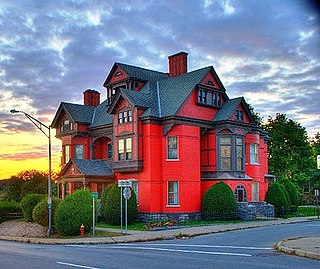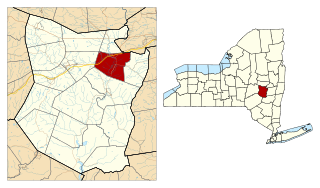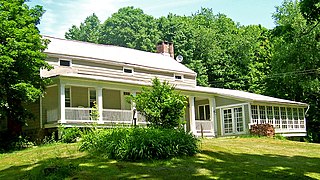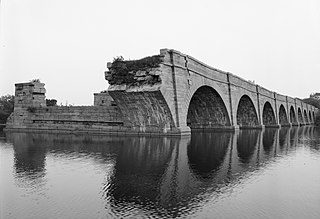
Montgomery County is a county in the U.S. state of New York. As of the 2010 census, the population was 50,219. The county seat is Fonda. The county was named in honor of Richard Montgomery, an American Revolutionary War general killed in 1775 at the Battle of Quebec.

Danube is a town in Herkimer County, New York, United States. The population was 1,039 at the 2010 census. Early Palatine German immigrants in the eighteenth century named the town after the Danube River in Europe.

Fort Plain is a village in Montgomery County, New York, United States. As of the 2010 census, the village population was 2,322. The village is named after a fort built during the American Revolution at the junction of the Mohawk River and its tributary Otsquago Creek.

Nelliston is a village in Montgomery County, New York, United States. The population was 596 at the 2010 census. The name is from members of the Nellis family.

Town of Palatine is a town in Montgomery County, New York, United States. It is located on the north side of the Mohawk River in the northwestern part of the county. The population was 3,240 at the 2010 census, the highest since the 1820s. The name is derived from the Palatinate in the Rhineland, the homeland of the Germans who were the earliest European settlers of this region. Administrative offices of the town are located in Palatine Bridge

Herkimer is a village on the north side of the Mohawk River and the county seat of Herkimer County, New York, United States, about 15 miles (24 km) southeast of Utica. As of the 2010 census, it had a population of 7,743. It was part of the Burnetsfield Patent and the first European-American settlement this far west in the Mohawk Valley.

Canajoharie is a village in the Town of Canajoharie in Montgomery County, New York, United States. As of the 2010 census, the village had a population of 2,229. The name is said to be a Mohawk language term meaning "the pot that washes itself," referring to the "Canajoharie Boiling Pot," a circular gorge in the Canajoharie Creek, just south of the village.

Schoharie is a town in Schoharie County, New York. The population was 3,299 at the 2000 census.

The Mohawk Valley region of the U.S. state of New York is the area surrounding the Mohawk River, sandwiched between the Adirondack Mountains and Catskill Mountains. As of the 2010 United States Census, the region's counties have a combined population of 622,133 people. In addition to the Mohawk River valley, the region contains portions of other major watersheds such as the Susquehanna River.

The Jacob Bookstaver House is located off Albany Post Road in Orange County, New York's Town of Montgomery, not far from The Smith House. It has been a Registered Historic Place since 1996.

Schoharie Crossing State Historic Site, also known as Erie Canal National Historic Landmark, is a historic district that includes the ruins of the Erie Canal aqueduct over Schoharie Creek, and a 3.5-mile (5.6 km) long part of the Erie Canal, in the towns of Glen and Florida within Montgomery County, New York. It was the first part of the old canal to be designated a National Historic Landmark, prior to the designation of the entire New York State Barge Canal as a NHL in 2017.
Fort Hunter is a hamlet in the Town of Florida in Montgomery County, New York, west of the capital at Albany, on the south bank of the Mohawk River and on the northeast bank of Schoharie Creek.

Palatine Church, also known as Palatine Evangelical Lutheran Church, is a historic Evangelical Lutheran church on Mohawk Turnpike in Palatine, Montgomery County, New York. It was built in 1770 and is a small, rectangular, one story structure with massive stone walls. It features a traditional meetinghouse plan.

The German Reformed Sanctity Church Parsonage, also known as the First Reformed Church Parsonage, is located on Maple Avenue in Germantown, New York, United States. It is a wood, brick and stone building dating to the mid-18th century, the oldest building in the town of Germantown. In 1976 it was listed on the National Register of Historic Places.

Van Alstyne Homestead is a historic home located at Canajoharie in Montgomery County, New York. It is a long, low rectangular house with a steeply pitched gambrel roof in the Dutch Colonial style. The original fieldstone house was built before 1730 and has three rooms with a garret under the roof. A 2 1⁄2-story frame addition runs across the rear.

Peter Ehle House is a historic home located at Nelliston in Montgomery County, New York. It was built about 1826 and is a rectangular, two story stone building with a gable roof and inside end chimneys in the Late Federal style. Also on the property is a large barn complex including a large frame barn, two carriage houses, and a small stone outbuilding. Remains of a large part stone barn are also present.

Frey House is a historic home located at Palatine Bridge in Montgomery County, New York. It was built in 1808 and consists of a double-pile, center-hall-plan main block with a 1 1⁄2-story, stone kitchen wing added in 1882, and sun porch dated to 1931. Also on the property are a five-bay garage, 19th-century lime kiln, and the Frey family cemetery.
Rice's Woods is an archaeological site located at Canajoharie in Montgomery County, New York. S. L. Frey, the pioneer Mohawk Valley archaeologist, believed that the Mohawk village site in Rice's Woods, on Big Nose, was Canajorha, the Middle Castle of the Mohawks after about 1677. Other authorities believe that it was the Lower Castle at this same period.

Tryon County was a county in the colonial Province of New York in the British American colonies. It was created from Albany County on March 24, 1772, and was named for William Tryon, the last provincial governor of New York. The county's boundaries extended much further than any current county. Its eastern boundary with the also-new Charlotte County ran "from the Mohawk River to the Canada line, at a point near the old village of St. Regis and passing south to the Mohawk between Schenectady and Albany." It extended north to the St. Lawrence River; its western boundary was the Treaty of Fort Stanwix's Line of Property, following the Unadilla River, Oneida Lake, Onondaga River and Oswego River to Lake Ontario, as the Iroquois Confederacy still controlled locations further west in the Indian Reserve. Tryon County's seat was Johnstown, which is today the county seat of Fulton County. The Tryon County Courthouse, built in 1772–1773, was listed on the National Register of Historic Places in 1972. The Tryon County Jail, also built in 1772–1773, was listed on the National Register of Historic Places in 1981.
















